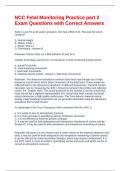Exam (elaborations)
NCC Fetal Monitoring Practice part 2 Exam Questions with Correct Answers
- Course
- Institution
Sally is a G4 P3 at 35 weeks' gestation. She has a BMI of 32. This puts her which category? A. Normal weight B. Obese, Class I c. Obese, Class 2 D. Overweight - Answer-B Rationale: Obese Class I is a BMI between 30 and 34.9. Doppler technology used by the US transducer in fetal monitor...
[Show more]



